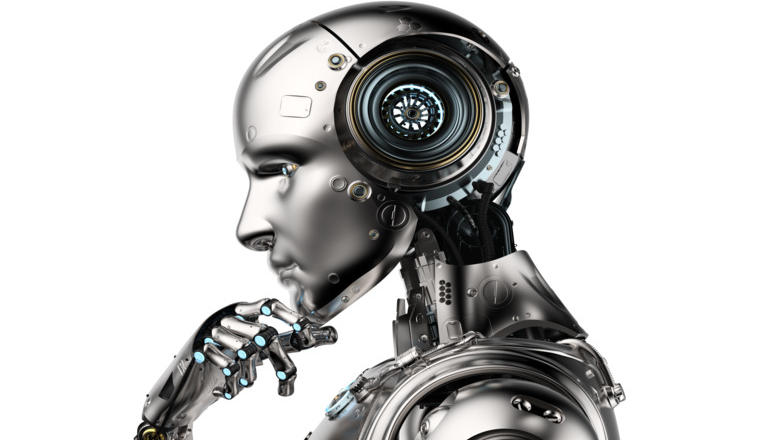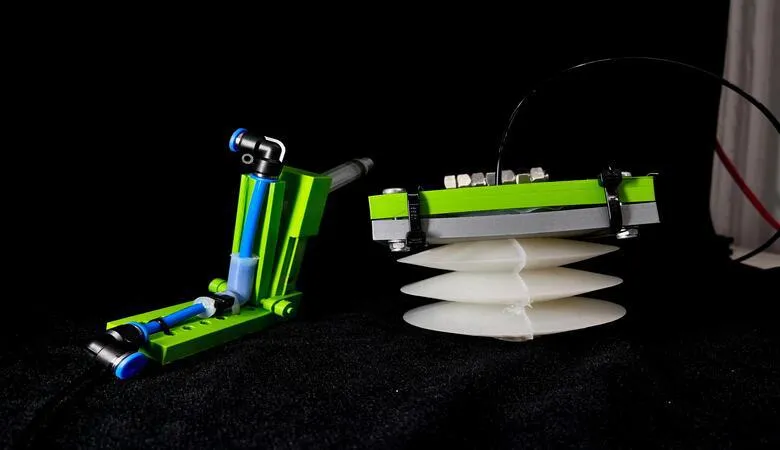By creating a hardware system independent from the software running it, we can offload a lot of the computational load onto the hardware, in the same way your brain doesn’t need to tell your heart to beat.”
Dr Antonio Forte
09 October 2024
New breakthrough helps free up space for robots to 'think', say scientists
This could lead to the next generation of robots being smarter and more social than their predecessors.

Engineers have worked out how to give robots complex instructions without electricity for the first time which could free up more space in the robotic ‘brain’ for them to ‘think’.
Mimicking how some parts of the human body work, researchers from King’s College London have transmitted a series of commands to devices with a new kind of compact circuit, using variations in pressure from a fluid inside it.
They say this world first opens up the possibility of a new generation of robots, whose bodies could operate independently of their built-in control centre, with this space potentially being used instead for more complex AI powered software.
“Delegating tasks to different parts of the body frees up computational space for robots to ‘think,’ allowing future generations of robots to be more aware of their social context or even more dexterous. This opens the door for a new kind of robotics in places like social care and manufacturing,” said Dr Antonio Forte, Senior Lecturer in Engineering at King’s College London and senior author of the study.
The findings, published in Advanced Science and awarded the frontispieces of the journal for “outstanding results”, could also enable the creation of robots able to operate in situations where electricity-powered devices cannot work, such as exploration in irradiated areas like Chernobyl which destroy circuits, and in electric sensitive environments like MRI rooms.
The researchers also hope that these robots could eventually be used in low-income countries which do not have reliable access to electricity.
Dr Forte said: “Put simply, robots are split into two parts: the brain and the body. An AI brain can help run the traffic system of a city, but many robots still struggle to open a door – why is that?
“Software has advanced rapidly in recent years, but hardware has not kept up. By creating a hardware system independent from the software running it, we can offload a lot of the computational load onto the hardware, in the same way your brain doesn’t need to tell your heart to beat.”
Currently, all robots rely on electricity and computer chips to function. A robotic ‘brain’ of algorithms and software translates information to the body or hardware through an encoder, which then performs an action.

In ‘soft robotics,’ a field which creates devices like robotic muscles out of soft materials, this is particularly an issue as it introduces hard electronic encoders and puts strain on the software for the material to act in a complex way, e.g. grabbing a door handle.
To circumvent this, the team developed a reconfigurable circuit with an adjustable valve to be placed within a robot’s hardware. This valve acts like a transistor in a normal circuit and engineers can send signals directly to hardware using pressure, mimicking binary code, allowing the robot to perform complex manoeuvres without the need for electricity or instruction from the central brain. This allows for a greater level of control than current fluid-based circuits.
By offloading the work of the software onto the hardware, the new circuit frees up computational space for future robotic systems to be more adaptive, complex, and useful.
Soon, if we do not offload the computational load that modern day robots take on, algorithmic improvements will have little impact on their performance. Our work is just a first step on this path, but the future holds smarter robots with smarter bodies.”
Mostafa Mousa, Post-graduate Researcher
As a next step, the researchers now hope to scale up their circuits from experimental hoppers and pipettes and embed them in larger robots, from crawlers used to monitor power plants to wheeled robots with entirely soft engines.
Mostafa Mousa, Post-graduate Researcher at King’s College London and author said: “Ultimately, without investment in embodied intelligence robots will plateau. Soon, if we do not offload the computational load that modern day robots take on, algorithmic improvements will have little impact on their performance. Our work is just a first step on this path, but the future holds smarter robots with smarter bodies.”


